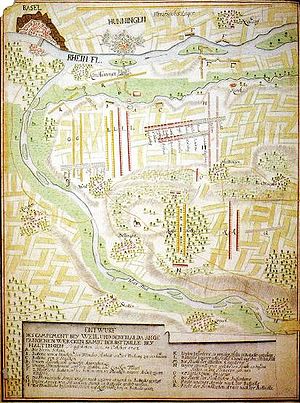Battle of Friedlingen
| Battle of Friedlingen | |||||||
|---|---|---|---|---|---|---|---|
| Part of the War of the Spanish Succession | |||||||
 Map of the Battle of Friedlingen; French = yellow; Imperial Army = red; North is on the right side |
|||||||
|
|||||||
| Belligerents | |||||||
|
|
|
||||||
| Commanders and leaders | |||||||
| Claude Louis Hector de Villars | Louis William, Margrave of Baden-Baden | ||||||
| Strength | |||||||
| 17,000 men, 33 cannons | 14,000 men | ||||||
| Casualties and losses | |||||||
| 1703 killed, 2601 wounded | 3000 killed, 742 wounded | ||||||
The Battle of Friedlingen was fought in 1702 between France and the Holy Roman Empire. The Imperial forces were led by Louis William, Margrave of Baden-Baden, while the French were led by Claude Louis Hector de Villars. The French were victorious.
The French were seeking to expand their influence on the eastern bank of the river Rhine. In the autumn of 1702, Villars received orders from Louis XIV to attack Swabia. The French forces needed to join their Bavarian allies and defeat the Imperial troops that stood between them.
The French crossed the Rhine at Weil am Rhein, just north of Basle on 14 October 1702. Villars attacked the Imperial army at Friedlingen. The future field marshal Louis William entrenched his army and managed to hold the French for some time. He then retreated in good order to the North.
It was a Pyrrhic victory for Villars. French losses were high: 1,703 dead and 2,601 wounded, whereas the Imperial forces lost 3,000 dead and 742 wounded. Villars was also prevented from joining the Bavarians.
The villages on the eastern bank of the Rhine suffered much damage, especially Weil am Rhein.
...
Wikipedia
